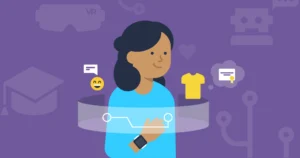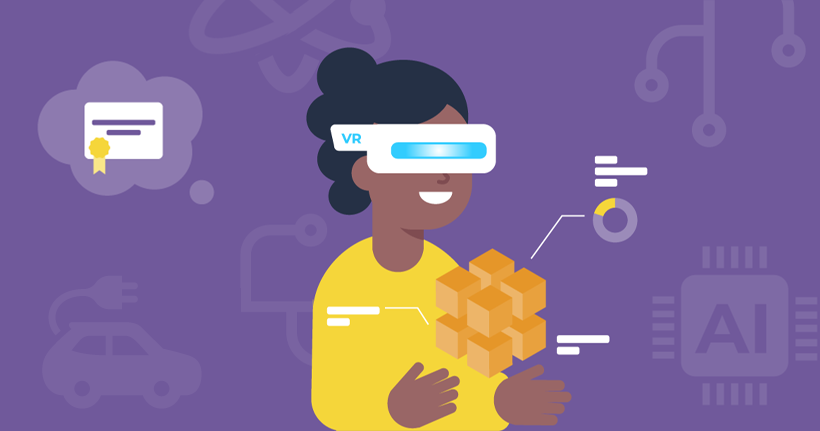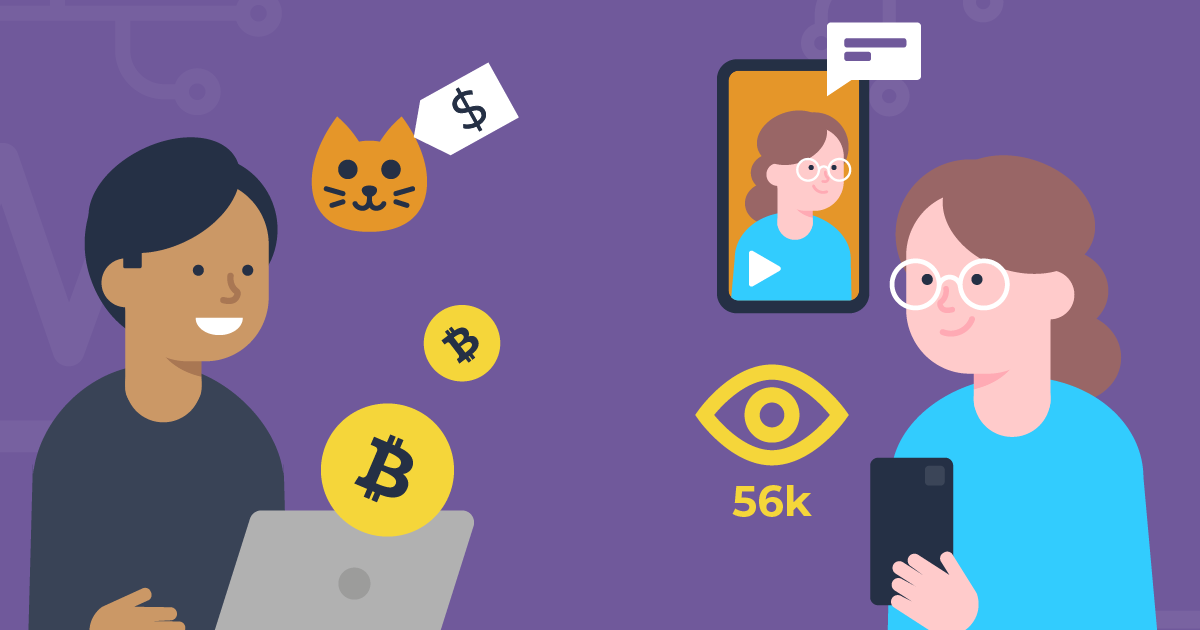What is immersive learning in the metaverse?
Learn what immersive learning looks like, how it fits into
the metaverse and how you can help children make the most of its technology.

In this guide
- What is immersive learning?
- What is the metaverse?
- How kids can learn with Roblox
- How the metaverse impacts kids
- Tips to stay safe in the metaverse
- Meet the experts
- Explore more Tech and Kids
What is immersive learning?
Immersive learning is a method of using virtual reality to explore and learn. It can teach children a range of topics through exploration and experience.
For instance, if a child learns about space, they can potentially fly around or visit planets in our solar system. In History, they could visit Britain before the Normans landed. Then, in English, they could explore Middle Earth.
 Close video
Close video
Immersive learning can engage children in their learning more deeply and in more exciting ways. For schools, this could mean engaging more children; at home, this could mean spending screen time actively building skills.
Other terms to know
Extended reality or XR is the overarching term for the other ‘realities’: Virtual reality (VR), augmented reality (AR) and mixed reality (MR).
The future of extended reality
While VR headsets and games are becoming more popular, there are also advancements being made for areas outside of video games. For example, Microsoft HoloLens boasts the ability to support various industries including engineering, healthcare and education.
As technology continues to develop, we’re likely to see great advancements in Science and Healthcare because of these devices. As such, the skills children will need to thrive within these new industries are likely to change rapidly year after year. Therefore, encouraging immersive learning and skill-building now can support their future.
Virtual reality or VR is a technology where users can experience digital worlds as if they’re real. Typically, users wear a type of headset with a screen and headphones built in. They then play a game or explore a world with the use of hand controls and eye or body movements.
Many families own VR headsets. However, there are also a collection of businesses that offer virtual reality gameplay at different locations. VR can often cause nausea in its users, so this could be a way to experiment with VR before purchasing a home headset.
Augmented reality or AR is a technology that uses a device like a smartphone to alter the surrounding physical space.
A well-known example of AR is Pokemon Go. While pointing your smartphone at an area in front of you, a Pokemon could appear. Users would then try to capture the creature to add to their collection. It used the offline world as a map and encouraged gathering of many people.
Other examples of AR apps and games include Wizards Unite, Zombie, Run! and Isle of Pigs from Angry Bird.
Mixed reality or MR is similar to augmented reality. With both, virtual and real spaces work together. However, mixed reality lets users interact with real-world objects that create 3D images in the virtual space. Augmented reality, on the other hand, simply overlays virtual images on top of real-world images.
For example, with Pokemon Go and AR, a user can hold up their phone and see the Pokemon. If the user tries to move closer, the Pokemon will stay where it is on the smartphone. It won’t increase or decrease in size, change direction or become more detailed. However, with MR, it’s possible to see all of those differences with the right device and programme.
Mixed reality offers users a way to change and interact with objects. Additionally, it can add virtual elements to the world in front of you — for instance, watching a how-to video while you do the task without needing to hold a device and without losing sight of it.
What is the metaverse?
There is no single definition of the ‘metaverse’. In very broad terms, the metaverse is a shared world where people can interact, learn, work, shop and play – essentially an immersive version of the internet.
The metaverse consists of a network of interconnected virtual worlds, each with different features and rules, and users can move freely from one world to the other. Users of the metaverse have the ability to create and modify the environment themselves, as well as to explore and interact with worlds created by others.
The metaverse is built on a combination of virtual reality (VR) and augmented reality (AR) technologies – known collectively as extended reality (XR).
Immersive learning in the metaverse
Immersive learning can take many shapes in the metaverse. While it’s an evolving technology, there are already virtual tours and experiences available.
Arts & Culture Expeditions from Google, for instance, allow teachers and parents to lead children through ruins, international museums and underwater exploration. Exploring Google Maps or Google Earth can help children visit far away places from the comfort of home.
In addition to these virtual field trips, the metaverse and extended reality opens up the possibility of simulated experiences such as building simple machines or visiting historical periods.
The metaverse also opens up opportunities for children to work and learn with others while developing key communication and critical thinking skills. Furthermore, children have the opportunity for learning experiences personalised to their interests and passions.
How can kids learn with Roblox?
Roblox is a place for people to connect with optimism and civility as they create, explore, play and learn together, says Head of Education at Roblox, Rebecca Kantar.
It offers users an endless library of places to go and impossibilities to experience in physical reality brought to life as stunning, immersive worlds, games and social spaces.
Because students already associate Roblox with feelings of adventure, self-confidence, novelty and social connection, the platform is a natural immersive learning tool. Educators, parents and students can achieve the kinds of deep learning and skills-practice that are otherwise difficult to bring to the foreground of instructional time.
Today, the immersive, 3D learning experiences on Roblox offer students new ways to discover scientific phenomena, explore places in history, learn to code or iterate as engineers do when developing new technologies.
Immersive learning opportunities on Roblox
Students can design, build, and iterate on their rover to explore Mars, with real data from NASA guiding the dynamic feedback loops between vehicular performance during interactions with Mars’ terrain.
Students can venture deep into the ocean for a conservational journey to explore and restore ecosystems with MIZU.
For curious learners interested in art, culture and history, a journey through the The Metropolitan Museum of Art on Roblox offers up-close interaction with precious works.
For students interested in building games of their own, Lua Learning offers the chance to begin learning to code in Lua, the programming language Roblox Studio employs.
Dynamic feedback loops, multiplayer functionality and immersive art and physics capacities make Roblox a compelling destination for outstanding developers to bring educational opportunities to life.
How the metaverse might impact kids
“As the metaverse continues to evolve,” says Justin Winters, “children can look forward to a number of groundbreaking experiences.”
These virtual experiences can blend education, entertainment and social interactions through virtual field trips to distant plants, time travel adventures, interactive wildlife safaris, underwater explorations and more, says Justin.
“The future of the metaverse holds the potential to revolutionise how we learn, making the digital world an even more integral part of a child’s development and exploration.”
However, as with any form of new and developing technology, it’s important to consider the impacts on children. For the metaverse, which is fairly new, parents and carers should consider how the space could impact children — especially young ones and those with additional needs.
Simone Vibert and Lizzie Reeves outline the risks and benefits below.
The risks of engaging with the metaverse
The use of headsets may make it challenging for parents to supervise their child’s interactions in the metaverse or to identify inappropriate content and interactions. Therefore, immersion might increase the risk of exposure to harmful content, such as pornography and graphic depictions of violence.
As social interaction is central to many metaverse platforms, children also face risks of bullying, harassment and abusive behaviour from other users. The immersive nature of the metaverse may make these experiences more realistic and harmful.
The Government developed the Online Safety Act. The Act is legislation which will make technology companies more accountable for the safety and wellbeing of their users, especially children. It is likely that this will affect companies that provide services in the metaverse.
Under online safety regulation, metaverse companies will need to do more to identify and remove illegal content, enforce their terms and conditions and tackle children’s exposure to legal but harmful content. This type of content includes pornography, self-harm and suicide content, violence, hate speech and bullying.
However, some open questions remain about how online safety provisions will be enforced in the metaverse. In our report on the metaverse, we argue that regulation needs to keep pace with emerging digital environments. This includes the metaverse, such as through a dedicated Code of Practice on extended reality.
The benefits of engaging with the metaverse
Justin Winters says, “the metaverse transcends gaming.” It opens doors to innovative entertainment and education that can enrich the digital experiences of younger generations.
For instance, the metaverse could help children hone new skills and experiment with new things in a safe and controlled environment. It is a space that encourages users’ creativity by building new interactive worlds, games and animations, either on their own or in teams. As such, it offers a more active experience than passively consuming content.
Additionally, it could give children who struggle with day-to-day interactions a chance to practise conversing with other users in a safe space. This might boost their confidence in the real world, particularly in school.
Spending time in the metaverse can also help build children’s critical thinking skills through play.
“Through mindful engagement and guidance,” adds Justin, “parents can empower their children to fully embrace the opportunities our digital future holds.”
One benefit of the digital space is the accessibility and ease of communication. This means vulnerable children such as those with autism, who find it difficult to communicate with others offline, can find community online.
The metaverse and extended reality offer even more interaction online. With VR headsets, children otherwise limited in movement can explore and move just like anyone else. Additionally, some tech only requires eye movement or upper body use, meaning more children can access the metaverse and immersive learning.
However, extended reality (and immersive learning by extension) could lead to negative impacts on physical wellbeing. Prolonged inactivity, nausea and environmental danger are all potential harms.
Additionally, devices designed for adults might not take into consideration children’s size or development. As such, children could face greater risks of eye strain, fatigue or dizziness as well.
Ultimately, every child is different as are their abilities. So, parents and carers should consider the individual when making decisions around immersive learning and the metaverse.
How to keep kids safe in the metaverse
Immersive learning, the metaverse and extended reality offer plenty of opportunities for children to build skills and learn about the world.
Supporting your child in their online life remains the same in the metaverse as in any other digital space. “Conversations are key,” says Lizzie Reeves. “Show an interest in what your child is doing online; try participating with them. And don’t be daunted – you don’t need to know everything about a platform or technology to help your child enjoy them safely.”
Here are some other tips to get the most of the metaverse and immersive learning:
If your child expresses interest in using extended reality or engaging with the metaverse, read up on what it means. A virtual reality headset, for instance, will mean something different than an app that uses AR. Additionally, every VR game will have its own content and ratings.
Discuss with your child what they’re interested in and why, and then try it out with them. This will help you understand the benefits and risks to make an informed decision.
Extended reality and immersive learning are not limited to the home. Children can engage with the metaverse in a range of safe ways that help them learn through businesses, museums and experiences.
Keep an eye out for special exhibitions that feature VR experiences or AR tours at local museums. Or, explore online options such as Beyond the Walls from the Smithsonian American Art Museum or virtual tours.
Additionally, there are a range of VR titles available to teach different topics. Explore space with Universe Sandbox or the HMHS Britannic with Britannic: Patroness of the Mediterranean. Alternatively, engage with AR apps such as SkyMap where you can explore the stars.
As with anything, moderation is key. Ensure your child has a healthy mix of activities they do both online and off to ensure their screen time is balanced.
Set screen time limits and explore other parental controls available with your child’s device. Controls might include ways to restrict who can contact your child, how much your child can spend and what kinds of games or apps they can access.
For older children, make sure to include them in the conversation and process around setting parental controls. This helps them understand why they’re important. Additionally, it makes it far more likely they’ll take ownership of their safety and stick with the settings you chose together.
Extended reality is an exciting concept for many children. That new device or headset might get a lot of use. However, make sure they find time to make use of the ability to immerse themselves in learning.
It’s easy to simply play or experience passive XR. Therefore, parents and carers should help their children out by finding apps and games to support immersive learning.
Learn how you can encourage children to build skills with advice from our expert panel.
Meet the experts

Rebecca Kantar is Vice President of Education at Roblox. Rebecca is a two-time founder, having sold her first company, an expert network, to Gerson Lehrman Group, and her second company, Imbellus, a provider of simulation-based assessments that evaluate deep thinking skills, to Roblox. Rebecca left Harvard College in 2012.
“We believe students across the world deserve to learn on Roblox,” she says. “We’re committed to making sure people can access the kinds of experiences that may otherwise be out of reach due to cost, geographic boundaries or physical-world constraints. We look forward to hosting 100 million students learning on Roblox by 2030.”

Lizzie Reeves works for Ofcom to help develop Online Safety Policy for the UK. She previously worked within the policy team at Internet Matters and the office of the Children’s Commissioner where she specialised in child online safety policy.

Simone Vibert is Policy Lead for Ofcom, helping to develop Online Safety Policy. Previously, she was Head of Policy and Research at Internet Matters. She is author of A Whole New World? Towards a child-friendly metaverse, a report that looks into the risks and benefits of the metaverse along with actions needed to keep children safe.

Justin Trevor Winters is a full-time faculty member in the Screenwriting for Film and Television Department at Loyola Marymount University, a part of the LMU Ignite Innovation Program as a writer and futurist and chairs the LMU AI Alliance.
He is also the co-founder and CEO of Verified Labs, an end-to-end AI transformation service specialising in bringing talent, brands and IP owners into the immersive web.
Some of his clients include the Estates of Ernest Hemingway, Steve McQueen and Bing Crosby as well as the Academy of Motion Picture Arts and Sciences, The BIG3 Basketball League and Triumph Motorcycles.
Explore more Tech and Kids
Read more Tech and Kids guides to keep children safe with future technology.
 Close video
Close video
 Close video
Close video
 Close video
Close video
 Close video
Close video
 Close video
Close video






